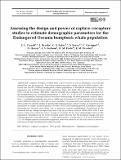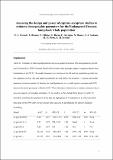Files in this item
Assessing the design and power of capture-recapture studies to estimate population growth rate and abundance of the endangered Oceania humpback whale population
Item metadata
| dc.contributor.author | Carroll, Emma Louise | |
| dc.contributor.author | Brooks, Lyndon | |
| dc.contributor.author | Baker, C. Scott | |
| dc.contributor.author | Burns, Daniel | |
| dc.contributor.author | Garrigue, Claire | |
| dc.contributor.author | Hauser, Nan | |
| dc.contributor.author | Jackson, Jennifer | |
| dc.contributor.author | Poole, Michael | |
| dc.contributor.author | Fewster, Rachel | |
| dc.date.accessioned | 2015-09-02T09:40:02Z | |
| dc.date.available | 2015-09-02T09:40:02Z | |
| dc.date.issued | 2015 | |
| dc.identifier | 197232695 | |
| dc.identifier | c32887c1-40b8-4ed2-874e-025c156b15e8 | |
| dc.identifier | 84982766573 | |
| dc.identifier | 000361551100006 | |
| dc.identifier.citation | Carroll , E L , Brooks , L , Baker , C S , Burns , D , Garrigue , C , Hauser , N , Jackson , J , Poole , M & Fewster , R 2015 , ' Assessing the design and power of capture-recapture studies to estimate population growth rate and abundance of the endangered Oceania humpback whale population ' , Endangered Species Research , vol. 28 , pp. 147-162 . https://doi.org/10.3354/esr00686 | en |
| dc.identifier.issn | 1863-5407 | |
| dc.identifier.uri | https://hdl.handle.net/10023/7392 | |
| dc.description | Funding for Open Access publication was provided by the University of St. Andrews. | en |
| dc.description.abstract | Capture-recapture studies offer a powerful tool to assess abundance, survival and population rate of change (λ). A previous capture-recapture study, based on DNA profiles, estimated that the IUCN-listed Endangered Oceania population of humpback whales had a superpopulation size of 4,329 whales (95% CL 3345, 5315) and λ = 1.03 (95% CL 0.90-1.18) for the period 1999-2005. This low estimate of λ contrasts with the high estimated λ of the neighbouring east Australia population (1.11; 95% CL 1.05-1.13). A future assessment of Oceania humpbacks through capture-recapture methodology has been proposed to meet 3 objectives: (1) estimate population size with a coefficient of variation (CV) of <20%, and detect if λ is significantly different from (2) 1.00 or (3) λ of east Australia. The proposed survey design involves identifying whales through DNA profiles on principal breeding grounds within Oceania in proportion to the abundance of whales on these grounds over the 10-12 week wintering period, to minimise heterogeneity between individuals and to maximise capture probabilities. Simulations of the idealised survey design incorporating data from the previous surveys (1999-2005) with three new survey years were conducted under a range of scenarios for the 'true' demographic status of the population. Simulations of the entire Oceania region showed that the proposed design will give sufficient power to meet (1) under all scenarios, meet (2) if the true λ≥1.05 and meet (3) if the true λ ≤1.05. Region-specific simulations suggested there was scope to test for differences in recovery between principal breeding sites within Oceania. | |
| dc.format.extent | 16 | |
| dc.format.extent | 351741 | |
| dc.format.extent | 154124 | |
| dc.language.iso | eng | |
| dc.relation.ispartof | Endangered Species Research | en |
| dc.subject | Capture-recapture | en |
| dc.subject | DNA profile | en |
| dc.subject | Heterogeneity | en |
| dc.subject | Megaaptera novaeangliae | en |
| dc.subject | QH301 Biology | en |
| dc.subject | GC Oceanography | en |
| dc.subject.lcc | QH301 | en |
| dc.subject.lcc | GC | en |
| dc.title | Assessing the design and power of capture-recapture studies to estimate population growth rate and abundance of the endangered Oceania humpback whale population | en |
| dc.type | Journal article | en |
| dc.contributor.institution | University of St Andrews. School of Biology | en |
| dc.contributor.institution | University of St Andrews. Sea Mammal Research Unit | en |
| dc.identifier.doi | 10.3354/esr00686 | |
| dc.description.status | Peer reviewed | en |
This item appears in the following Collection(s)
Items in the St Andrews Research Repository are protected by copyright, with all rights reserved, unless otherwise indicated.


